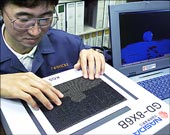Jinxed Japanese space programme
An unmanned Japanese space shuttle prototype crash landed during testing in northern Sweden on Wednesday, Swedish space authorities said.

A stratospheric balloon hoisted the test shuttle, part of Japan’s programme to develop its first reusable shuttle, to an altitude of 21.5 km and released it into free-fall. Everything went as planned until the shuttle reached 1200 metres.
The prototype should have landed using a system involving a parachute and an airbag, but instead it came crashing down onto the testing centre in Kiruna, some 1300 km north of Stockholm, breaking up.
“The recovery system did not work properly to give it a soft landing. It has to be refurbished before it can fly again,” said project leader Mikael Viertotak at the Swedish Space Corporation.
“Of course it causes a delay in their experiment… and a delay usually means extra costs,” Viertotak told journalists. “But I would not consider this a major drawback.”
The Japanese space program is undergoing a major reorganization in the wake of six major failures in the past six years.
Promising start ends in disaster
In 1994, with the successful launch of the H 2 rocket, Japan appeared to be on track to achieving status as a major space-faring nation.
Since the mid-1970s, the National Space Development Agency of Japan (NASDA) had successfully launched 30 rockets. The H 2 launch on April 2, 1994, set the stage for Japan’s plans to develop an un-piloted space shuttle.
NASDA had become a force to be reckoned with, an organization capable of building the Japanese Experiment Module – the nation’s contribution to the International Space Station (ISS) project. And unlike its international counterparts – the United States and Russia in particular – Japan looked to deliver its module on time.
 |
| Back to square one or looking for what went right? |
But then things started to go wrong. Six major program failures in six years left Japan’s effort to join the elite club in crisis.
Tragic six years
In August 1994 Japan’s experimental communication satellite ETS 6 was lost in space when a malfunctioning kick motor sent the 2-ton experimental communication satellite ETS 6 whizzing into the Van Allen radiation belt.
In 1996, a shuttle prototype was lost during testing, sinking into the Pacific Ocean for ever.
In June 1997 the 3.5-ton flagship Advanced Earth Observing Satellite (ADEOS) said adios when its 26-metre-long, but millimetre-thin solar array twisted up like cellotape 10 months into an international global climate study.
Until 1998, NASDA’s satellites had stuttered, but not its rockets. But then their fortunes really took a turn for the worse.
Japan believed it had scored its first commercial success in the space industry with the H 2-A. It was to have vindicated Japan’s whole space program, pushing the cutting-edge of Japanese industrial technology into the new millennium.
But it had scored an own-goal. A premature shutdown on the LE 5-A sent the COMETS communications satellite into the wrong orbit in 1998.
Then, a faulty turbine on the LE 7 forced engineers to blow up the rocket and its air-traffic control MTSAT satellite last November 15.
With the pride of Japan’s rocketry smashed to bits over the Pacific Ocean STA’s deputy minister, then NASDA president Uchida resigned. NASDA cancelled H 2’s eighth and final flight and – more ominously – Hughes pulled out of its contract to use the H 2-A.